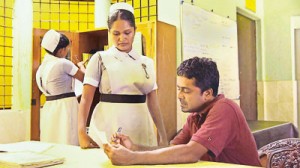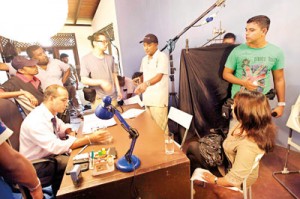Going beyond a story on the silver screen

Portraying a human being, not a patient: Shyam Fernando as Wishwa editing an official letter given by the nurse
Vindana and Kalpana Ariyawansa were movie buffs who always wanted to make high quality cinema in Sri Lanka. But despite having the resources and network through their father (one of Sri Lanka’s best loved songwriters, Kularatne Ariyawansa), they didn’t start the project until 2012. There were myriad story ideas to work with, but they chose the one that they were most familiar with: Vindana’s decade-long struggle with Obsessive Compulsive Disorder (OCD), and how it affected relationships in his life. His experience forms the core of their internationally- acclaimed debut: Premaya Nam or Dirty Yellow Darkness.
“We knew from the very first moment that it would be a challenge to make a story like this watchable,” Vindana says. “We had so much material, but as filmmakers we have to stick to certain parameters.”
“It’s difficult to make a simple movie, a movie that anyone can understand,” Kalpana explains. “We knew too much. We were so comfortable with the story and the incidents and what’s going on in the protagonist’s head, that the biggest challenge was ‘How are we going to make the audience understand.’”
The problem was solved when Jaan Shenberger, Kalpana’s long-time friend from college, first read the script.
Shenberger is a San Francisco-based freelance director-cinematographer who has worked on projects for clients like Nike, Adidas, Google, Disney, National Geographic Channel, Pepsi, and Sony. In 2000, he had promised the brothers that when they directed their first feature, he would do the camera work for them. It took 12 years for the occasion to arise, but he kept his promise.
“I was impressed by the bravery of the script,” he says. “The most beautiful thing to me was watching this character gradually admit to himself that he’s been making excuses and that he indeed can make a better effort at self-improvement for the sake of the people he loves. The protagonist is also the antagonist – more specifically, his stubbornness and pride is the villain. That’s a very complicated and messy concept to portray about something as sensitive as mental health, and I think they handled it wonderfully.”
Shenberger was able to be distant from Vindana’s personal narrative and recognised contextual blind spots in the script. The brothers then worked on fixing these.
“We had complete control of the creative process among the three of us ,” Vindana says highlighting the point that made the film an international critical success.

Collaborative process: Vindana (standing second from left) and Jaan (centre) discuss the scene with Kalpana (standing third from left)
Premaya Nam was first nominated for multiple awards at the 2015 Beijing International Film Festival, and then continued to prominent festivals in the Cayman Islands, Chicago, Kerala, Goa, Florida, Delhi and other locations.
Apart from making a good film, the Ariyawansas were very interested in telling the story as it was. For this, they brought Consultant Psychiatrist at the National Institute of Mental Health (NIMH) Dr. Kapila Ranasinghe into the film team.
Dr. Ranasinghe oversaw Vindana’s treatment over a decade. Like the Ariyawansa brothers, he is also an ardent film fan, albeit somewhat disillusioned by the standards of Sri Lankan cinema.
“Mental illness is depicted incorrectly in Sri Lankan cinema,” he says. “The industry uses mental illness most often only for shock value, or for novelty. But we [as psychiatrists] don’t see ‘crazy’ patients most of the time. Many of my patients are lawyers, professors, and sometimes even doctors! This film clearly showed that people with mental illness go about their daily work just like anyone else.”
The script is taken completely from Vindana’s personal experience. We see him at work, with his family, friends, and with his wife. There is no fiction, “except for the happy ending,” he says. This truthfulness brought them the unique victory of permission to shoot a large portion of the film within NIMH wards.
The support from NIMH and the Ministry of Health went so far as to allow Dr. Ranasinghe to conduct a day-long workshop in the hospital wards with the whole cast and crew, preparing them for the production.
Shyam Fernando (Oba Nathuwa Oba Ekka) plays the main character “Wishwa”. He already knew Kalpana and Vindana when he agreed to play the role, and he trusted them. But he had major reservations about his personal ability.
“I was concerned about the fact that I didn’t know how a person suffering from OCD behaves,” he says. “We have a certain stereotype that we fit a mentally ill person into, and I thought the character won’t be believable if I didn’t do it right.”
But through the workshops, and following a lot of pre-production work with Vindana, Fernando began to understand the role better.
“Working inside the hospital with doctors, we all realized that mental illness could be anywhere, with anyone,” he says. “They are normal people, leading a normal life. And just like all of us struggle internally and try to hide our weaknesses and problems, they too try to hide their illness.”
The revelation transformed how Fernando saw his role.
“I began approaching it as a problem that the man Wishwa had – a personal struggle. My focus shifted from portraying a patient, to portraying a human being.”

Samanalee Fonseka and Shyam Fernando: Happy endings are possible
What Fernando accomplishes, beautifully, is the portrayal of just another man trying to juggle the loves and hates in his life.
One of the most memorable scenes in the film is when Wishwa first meets his wife-to-be, Samadhi played by Samanalee Fonseka. She sits behind her desk at the bank, compiling an estimate of the interest payments on his loan. He sits across from her and solves the math problems for her before she finishes punching the numbers into her calculator. She is amazed. The spark is lit.
“Hopefully, some of the stigma associated with mental illness will be removed with this film,” says Dr. Kapila Ranasinghe. “Anyone who wants to know about relationship issues and mental health issues and how they can affect each other, should watch it… It’s also a good piece to critically analyze where we are in terms of cinema.”
More than anything though, the quality and honesty of the film has proven to connect with people.
“The Jaffna Film Festival experience was unforgettable,” Kalpana says. “Because 99% of the audience didn’t speak Sinhala, most of them came and hugged us. Some shook hands and embraced us because that’s the only way we could communicate.”
“If we have communicated the idea that you can get beyond [mental illness] and get better,” Vindana says, “we’ve achieved something.”


